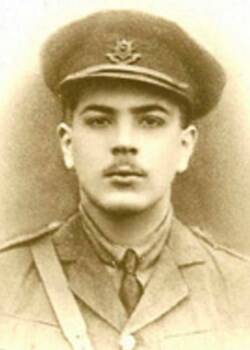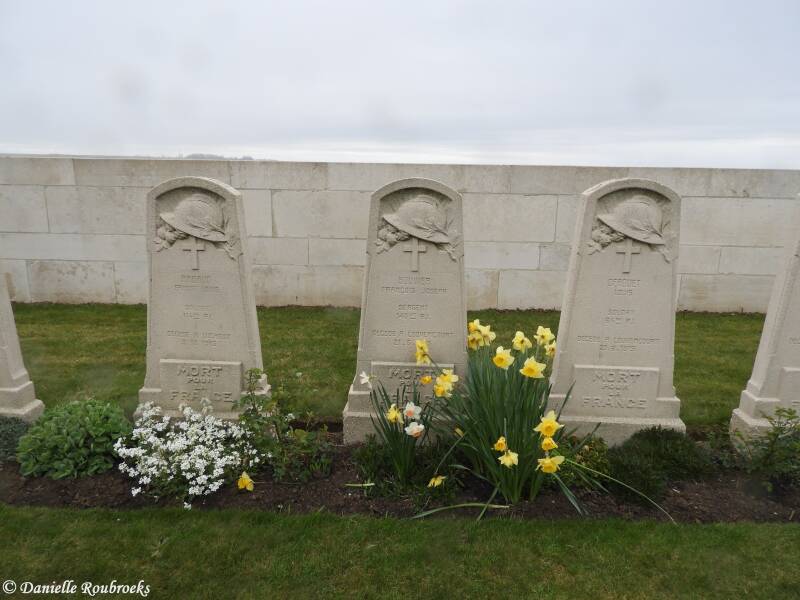Louvencourt Military Cemetery
Historical Information (Source: CWGC)
From July 1915 to August 1916, field ambulances were established at Louvencourt, which was nearly 10 kilometres behind the front line on 1 July 1916. Following the 1916 Somme offensive, these medical units moved further east and the cemetery was little used until the German advances of April 1918 pushed the Allied line back to its old position. The graves of 1918, in rows D and E, relate to the climax of that fighting. Eight of the graves in row E were brought from the Communal Cemetery Extension at Vauchelles-les-Authie, 1.6 Kms away on the road to Doullens. This extension was opened in July, 1916, for the Field Ambulances at Vauchelles, but no more than eight burials took place in it. There are now 151 Commonwealth burials of the First World War in this cemetery and 76 French war graves dating from 1915. The cemetery also contains three graves from the Second World War. The cemetery, one of the first three Commission cemeteries to be built after the First World War, was designed by Sir Reginald Blomfield.
Served with
- Canadian (4)
- New Zealand (17)
- United Kingdom (135)
Served in
- Air Force (2)
- Army (153)
- Navy (1)
Lieutenant Roland Aubrey LEIGHTON - 1st/7th Bn. Worcestershire Regiment - Died 23 December 1915 Age 20
Fiance of Vera Brittain - immortalised in Vera Brittain's memoir, Testament of Youth.
When World War I broke out in 1914, he was highly motivated to join the fighting by ideas of patriotism, honour and duty, and sought to get to the front. He first tried to get into the Royal Navy, but was turned down due to short-sightedness. For the same reason he was rejected by the Royal Artillery and the Army Service Corps. After this experience, he procured a "general fitness" certificate from a local GP which did not make reference to his myopia, and was able to secure a commission as a second lieutenant in the 4th Battalion of the Norfolk Regiment on 21 October 1914. From then on, Roland was only able to see Vera fleetingly during his brief periods of leave.
He was promoted a lieutenant with the Worcestershire Regiment on 26 March 1915. Leighton served with the Worcestershire Regiment in France, and was engaged in the fighting around Ypres in Belgium. Vera Brittain became his fiancée in August 1915.
In December 1915, he was shot by a sniper while inspecting the wire, in bright moonlight, in front of a trench at Hébuterne, France. He sustained a catastrophic abdominal and spinal injury. While still on the battlefield, he said simply, "They got me in the stomach and it's bad," before he was rendered semi-conscious by morphine. Leighton underwent emergency abdominal surgery at Louvencourt. However, he survived only a short time, dying of his wounds on 23 December 1915 at the age of 20.
Information (Source: Wikipedia)
Brigadier General Charles Bertie PROWSE - Cdg. 11th Infantry Bde. General Staff
Died 01 July 1916 Age 47
Awards: Distinguished Service Order, Mentioned in Despatches
Brigadier-General Charles Bertie Prowse, DSO (23 June 1869 – 1 July 1916) was a British Army officer. He joined the militia battalion of Prince Albert's (Somerset Light Infantry) Regiment in 1889 and transferred to a regular battalion in 1892. Prowse served in the Second Boer War from 1899 to 1902 with his regiment and as a staff officer. He was twice mentioned in despatches by Field Marshal Lord Roberts and received promotion to captain. Prowse became a major in 1914.
Prowse fought in many of the early actions of the First World War and commanded his battalion in action at Ploegsteert Wood, where a farm was named Prowse Point in his honour. He was mentioned in despatches by General John French on 8 October 1914 and four days later promoted to lieutenant-colonel. He briefly commanded the Prince of Wales's Leinster Regiment (Royal Canadians) before being promoted to brigadier-general in April 1915 and given command of the 11th Infantry Brigade. Prowse led his brigade in an attack on the first day on the Somme, where he was killed by machine-gun fire.




































